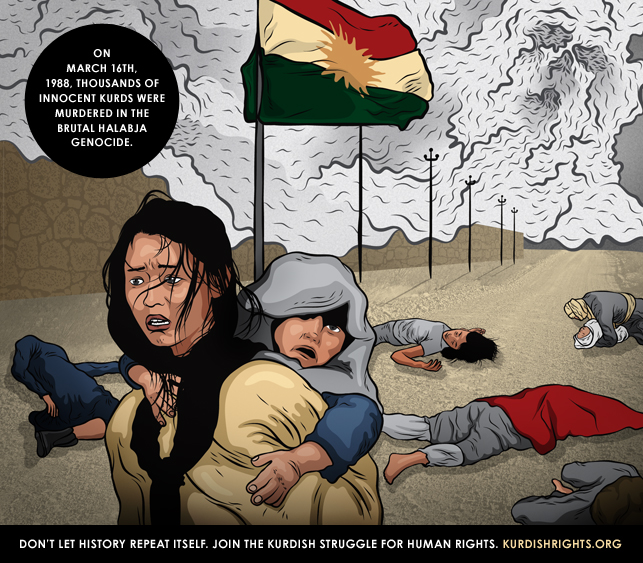Remembering Halabja: 26 years later

Today marks the 26th anniversary of the Halabja Genocide that claimed the lives of more than 5,000 Kurdish civilians in a poison gas attack carried out by the state of Iraq on the orders of then president Saddam Hussein. The massacre was part of the notorious Anfal campaign that was conducted from 1986 to 1989 and led to the deaths of countless Kurdish civilians, most of them women, children and elders, the displacement of at least 1 million people and the destruction of 4,000 villages.
A Human Rights Watch report details the events leading up to the Halabja Massacre and the devastation that followed:
The war between Iran and Iraq was in its eighth year when, on March 16 and 17, 1988, Iraq dropped poison gas on the Kurdish city of Halabja, then held by Iranian troops and Iraqi Kurdish guerrillas allied with Tehran.According to the testimony of survivors, the chemical weapons employed in Halabja were dropped from airplanes well after the town had been captured by Iranians and Iraqi Kurdish rebel forces allied with them, and after fighting in the immediate area had ceased.
The city’s 70,000 or so inhabitants, many of whom were refugees from outlying areas, had already been pounded for two days from the surrounding mountain heights by conventional artillery, mortars and rockets. Many families had spent the night in their basements to escape the bombs. When the gas came, however, that was the worst place to be since the toxic chemicals, heavier than air, concentrated in low-lying areas. Between and 4,000 and 5,000 people, almost all civilians, died either at the time or shortly thereafter.
Hewa, a university student, survived by covering his face with a wet cloth and taking to the mountains around the city. He says that Iraqi warplanes followed, dropping more chemical bombs. “I got some gas in my eyes and had trouble breathing. You always wanted to vomit and when you did, the vomit was green.He says he passed “hundreds” of dead bodies. Those around him died in a number of ways, suggesting a combination of toxic chemicals. Some “just dropped dead.” Others “died of laughing.” Others took a few minutes to die, first “burning and blistering” or “coughing up green vomit.” Journalists noted that the lips of many corpses had turned blue.
The following video shows the dead bodies scattered around after the chemical gas attack.
Warning! Graphic footage.
Comments
Pingback: Sharif Behruz's personal blog » REMEMBERING THE MASSACRE IN HALABJA: 26 YEARS LATER